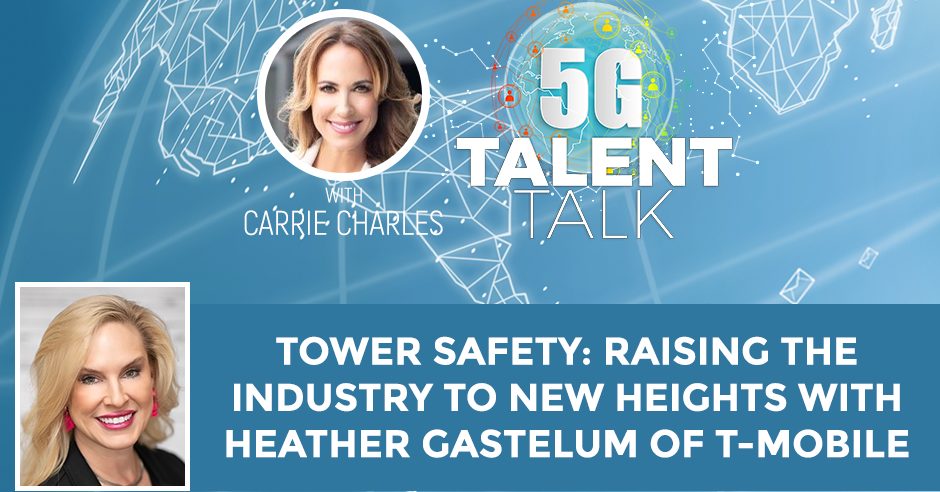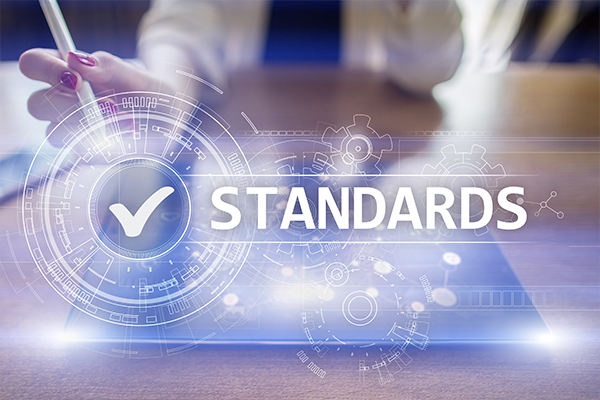
Just because accidents in this industry are inevitable doesn’t mean we should stop trying to add more safety measures. The Senior Manager for National Site Safety at T-Mobile, Heather Gastelum, refuses to accept construction-related fatalities as just part of the job. In this episode, she sits down with Carrie Charles to talk about tower safety. She also cites some specific challenges that both companies and the workforce face and some of their solutions. Heather then taps into the importance of training in creating safer workspaces, revising and raising industry standards, and keeping workers safe so we can continue to attract and engage our workforce in the field.
—
Watch the episode here:
Listen to the podcast here:
Tower Safety: Raising The Industry To New Heights With Heather Gastelum of T-Mobile
I am so happy that you are here with me. I’m even more excited to have my special guests with me. Heather Gastelum, welcome.
Thank you.
Heather is the Senior Manager for National Site Safety at T-Mobile. I have known Heather for a long time. I have seen her on panels and speaking ever since I’ve been in the industry. She’s always been a leader and out front. I am thrilled to have you on the show. We are going to have some fun with the conversation. The first thing that I would like to talk about is your journey in your career and especially how you got into telecom because that’s the coolest story.
When trades are being taken out of high school, we don’t have welding anymore.
For anyone who’s been in the industry for many years, it’s a random start. None of us set out to be at telecom but I feel like I need to take it back to spending a few summers working for my dad, who was an accustomed steel fabricator and a general contractor. I picked up more than I appreciated working for him, not only a strong work ethic and an extreme amount of integrity but a little other tidbits along the way.
The random start in telecom when my husband and I first moved up here, I took a temp job as a coordinator for a wireless company in Seattle, the birthplace of telecom. My next assignment after that was I was working on a construction scope at work. They quickly figured out I knew how to read drawings. I understood construction sequencing and how to deal with contractors, which I learned from my dad. Some of them were extra salty and that was like dealing with my dad. They took me out on the field and assigned me my first 25 sites. They were all raw land and were newly built back then. That’s back when we were stacking steel everywhere. It’s so random.
You have a real passion for safety and construction.

I’ve watched my father injured numerous times in working. Starting in his factory, that was back in the day when there were no machine guards and safety mechanisms. We still joke that my dad has nine lives. We still don’t know how he has all his digits and everything else. Back before machine guardian, his right-hand man, Javier, was like family to us. He tragically lost an eye one day and that impacted all of us greatly.
My father was almost killed when he was working on a factory floor. They were hoisting a galvanizing steel cage. They didn’t have it properly rigged and he wasn’t wearing a hardhat. The corner of the cage came down, cracked his skull and near killed him. I’ve personally had friends from very preventable construction-related fatalities. I’m very passionate about it. The old saying, “It comes with the job,” doesn’t fly with me.
You transformed your pain into purpose. You’re making a big difference in the industry and the lives of hundreds of people. Talk a little about your role at T-Mobile, maybe some of the boards and committees you sit on. You were so active and I have no idea how you even find time to sleep.
They brought me in to manage the TIRAP portfolio. At that time, when we would wind up having construction-related issues with any of the crews, I would be the one investigating that. I did take a bit of a hiatus after the TIRAP portfolio sold in 2012 to help our market launch 600. I put my development hat back on. They brought me back to headquarters to manage our vendor safety program. I’m allergic to not speaking up when I see something that’s not done the way that it should be done. A lot of my safety peers in the industry have recognized that. I’ve been invited and nominated to participate in some key safety-focused boards.
I’m on the Advisory Board for the Telecom Industry Registered Apprenticeship Program, which you’ve probably heard of named TIRAP. I’m one of the original Board of Governors on the National Wireless Safety Alliance. NWSA acquired the one-year ANSI National Accreditation Board, a one-year surveillance review process, which is a very big deal, and it was sent back in 2015. The ANSI Accreditation is something that’s not easy to gain.
I was nominated to participate on the OSHA Safety Committee as one of the carrier reps to provide the carrier’s perspective on that committee. I have been involved with some other committees across the industry, the TIA TR-14 Structural Committee, UAS Drone Committee from the safe work perspective, the Women of NATE. I’m the Washington State Liaison for the Wireless Industry Network.
Are you doing the right thing even when no one is looking?
You speak a lot on workforce development issues. You’re involved in so much. Let’s talk about some specific challenges that companies are facing, as well as maybe some challenges that the workforce is facing.
It’s across all construction trades. If you’re watching the news, you’re looking at all of the boats off the coast of California, we don’t have enough truck drivers to move goods around the country but from a service perspective, there is a challenge across all the construction trades. I saw a stat by the American Builder Contractor Association and they estimated that general contractors needed to hire another 433,000 workers for 2021, in addition to what they employed in 2020. That’s anchoring.
Are there any solutions that you see? Maybe you wake up in the middle of the night and say, “This would work. I have an idea.”
I’m passionate about it because I come from a unique perspective, the daughter of a blue-collar father and a white-collar mother. We’ve taken trade classes out of our high schools. There’s a program that’s involved that focuses on girls because statistically, they move away from science and math in third grade. There’s this organization. We get the opportunity to get in front of junior high and high school-age girls to talk about STEM careers.
When trades are being taken out of high school, we don’t have welding anymore. These kids are not getting involved. They might not even come from a family that has tools in the household. They might never have swung a hammer. My opportunity to learn how to utilize tools growing up was if I broke something, that was my opportunity to learn, “How to guess what you get to do now?” Not everybody had that opportunity.
If you look at the CDL, piece of the puzzle, collectively as an industry and I’m very passionate about this, all of us can do more by going in and talking down to the grade school, junior high and high school age. A lot of the career counselors seem to focus on high-tech and college, which is great but that doesn’t build our country and certainly doesn’t maintain our country. We need to remind these kids that they have other opportunities. Trades are not to be looked down upon. They are very well paid.
Crane operator is one little tidbit of an example. When I drive to work, I drove by 33 cranes. Crane operators typically make, across the country, $80,000 to $125,000 a year. That doesn’t include the cranes that are stacked. We have an opportunity to ensure that kids know that they have other options, not just high-tech. It’s great to talk about coding and high tech but we need a lot more to build our networks and keep our country running.
I’ve always said that we can’t even start in high school because the kids develop their interests and know what they’re passionate about. We’ve got to start younger where it becomes something that they have an interest in high school. Then after high school, they may choose a trade school instead of college. We’ve spoken before about a weakness in our industry with training and certification. What is that weakness? How can we do better?

We have training firms in our industry. Some do a phenomenal job training, others train and release them and don’t have any type of follow-up mechanism in place. There’s been a lot of growth in our industry. We’ve had new companies come into our industry that didn’t have a background, sometimes even in construction.
When you’re talking about sending your employees to be trained and you’re getting them trained as a trainer to come back and train your workforce, how are you validating and verifying that they properly understand the importance of what they are training and are properly trained to that curriculum, especially if you’re a supervisor that maybe doesn’t understand construction? Training companies would be held accountable. They should be going out and validating, verifying, even sending the secret chopper to some of these classrooms to make sure who they deemed as a trainer is following everything that they’re supposed to be following.
I’ve been very vocal about this concern. We don’t have in our industry yet a third-party accreditation or test mechanism. I’ve been talking to NWSA. I say, “Why did we not have a trainer credential?” It’s in conversation and I could see going somewhere. Those credentials take a massive amount of time and effort to generate a written and practical exam that a governing body like ANSI is going to approve. If we had a party mechanism to validate and verify that their trainers are confident and capable of training other individuals, that would go a long way towards ensuring we continue on this safer work practice that the industry has established.
We know that there’s a shortage of crews. Here at Broadstaff, we get calls, LinkedIn messages and emails all day long every week. “We need crews. We’ll take as many as you have.” It’s a shortage, crisis and only going to get worse. We know all of that. It’s a tough situation and challenging. We look at this and also see that our industry is exploding. New tower companies are entering the industry all the time. You have to wonder, when we talk about safety, is safety a number one concern? You help vendors become safer. Is safety a high priority for all of these companies? Are our climbers and technicians safer than they were years ago? If not, why?
You’ve got to remember a lot of tier-one companies have recognized the testing piece of the puzzle. If you test your workforce and ensure by sending them through an enabler saying, “You get them a triple T1 out of triple T2 and that’s a telecom tower technician exam that you can send them through,” we didn’t have that before. If you look back at 2013 and the tragedies that took place in 2013 and 2014 when we lost 24 lives, the industry recognized that. We reacted and responded to it. We have had over a hundred companies participate in developing those exams.
If you have crews that are contractually obligated to have a certain percentage of their workforce have at least a triple T1 on their crew, they’re going to be working safer. We can validate and verify that they know what they’re doing. The majority of our incidents, 65% over the last few years, are by crews that are root cause analysis shows us that we’re not following industry standards and not properly trained. If they were properly trained, they would have been following industry standards.
Industry reputation is a very valuable thing.
It’s important that with all the new growth and companies that have been coming into our business, that they understand what they’re responsible for as an employer. Our industry got together in 2015 after those tragic events. We’ve seen a shift towards safer work practices but because of that massive growth and we’ve had companies coming in that don’t even have a construction background sometimes, yet they’re the employer who’s legally obligated to ensure workers are properly trained for the hazards that they’re being exposed to.
That’s federal law. That’s not us making that contract. We’ve seen an improvement and for over 100 companies to participate in ensuring that it’s a safer industry, that type of collaboration has gone a long way. That’s why we see more tier-one type companies adopting it into their contracts because they see the results.
I’m so thankful because the companies can know that someone has the certifications, they know what they’re doing and can be safe. It’s so important. What else can companies do to make sure that their workers are safe? Is it something to do with culture? What are some other things that they can do?
Company culture goes a long way. Integrity matters. Are you doing the right thing even when no one is looking? If you didn’t hear that as a kid growing up, then hear it now because it is important. Not only are you doing the right thing when no one’s looking but you’ve got crew members that are willing to work with you because they trust you. They know that you’re going to keep them safer. Ensuring those safe work practices are performed.
There’s a lot of applicable standards that apply to our industry. The standards are always being revised because we learn from our mistakes. Those subject matter experts that we have that work on those standard revisions make sure that they take all those lessons learned and apply them. If the companies are following the guidelines and standards that have been applied to our business, it starts with the universal building code and works its way down to our industry-specific standards, they’re going to have a safer work practice and crews.
We know that costs are increasing. It’s a different time and climate that we’re living in but with safety, you cannot cut corners.
You can’t. We talked about the cost of training and other aspects of it. A fatal event can cost you a lot more than the cost of the fatality and the impacts on those families. The workmanship piece of the puzzle could cost a contractor their industry reputation, which can lead to termination. We have had some situations in our industry where we’ve seen companies that have been terminated by the majority of the hiring firms because after the fatality has been investigated by OSHA. Industry reputation is a very valuable thing. Our business is big but it’s very small in the same effect. I say that all the time because I’ve been around for so long but this industry is this big. We think it’s gigantic but it’s not. When it comes down to reputation, it’s incredibly small.
With the workforce being such a hot topic, talent, retention and it’s on everyone’s mind, some employers are hesitant to spend money and time on training and development. They say, “I spend all this time training people and then they leave me for $0.50 an hour.” How do we overcome this objection?
There are some tenured firms in our industry that don’t seem to have a problem with retention. There’s a handful that I can think of that I’ve worked with for years. They have workers that have been there since they opened their doors. Are you offering a career path for advancement? This is where the military transition is so beautifully into our business because ethics and moral is ingrained in them. They know that they can trust each other.
That path of advancement to take that rockstar on a crew, send them to NWSA, have them tested, promote them to a foreman who’s responsible for supervising and overseeing a crew, I have seen that prove out for even smaller general contractors who are and had been in our industry for many years. I don’t see heavy turnover there.
What I see heavy turnover are some of those newer companies that have come in. They’re trying to learn our space. They don’t understand all of the potholes that those of us that have been around for many years have all lived through. We’re allergic to repeating our mistakes. That career path for advancement, I’ve seen it proven out with other tenured contractors in our industry. They don’t have guys leaving for 0.50 cents an hour.

Talk about some workforce programs and solutions that are working where companies and leaders can get involved, find out more information that can help them attract and retain their workforce.
In the Telecommunication Industry Registered Apprenticeship Program, we’ve got about over 50 employers and over 2,000 apprentices that have signed up for that apprenticeship program. That is a government-funded initiative. TIRAP works with the Department of Labor. If an employer signs up to have apprentices, they come to you already trained. With the Department of Labor piece of the puzzle, those apprentices are earning college credit.
If an employer signs up to be an active participant in the TIRAP apprenticeship program, you’re getting already trained workers. You then get to mold them into your company culture, which hopefully is a safe work practice type culture, then they’re getting college credits. If they know that you’re willing to work with them and help them learn the business, not just what they can gain in the classroom but that on-the-job training in our industry is critical.
Even those cell sites are very similar. They’re all unique and different in their special way. If they don’t get that on-the-job training, perhaps they are only trained on a monopole and self-supporter, they are out on a tree tower. They need that OJT of, “How do I maneuver my way around with branches in the way?” They are getting college credit, so there are people that are committed to raising their hand going, “I might want to be involved in this industry.” Everybody has a computer in their pocket. We want them to start thinking about, “How does that work? What makes it work?”
Everyone that starts in the field, we’ve got RF engineers. We have plenty of jobs that require a degree and plenty that don’t. T-Mobile launched the NextTech Diversity Program. We are focused on getting into the more diverse communities. We have wares for wireless, which you are a former military and vet. I’m sure you’ve talked to Major General Kevin Kennedy about the ground. They were over almost 3,000 vets that they had run through the program. That’s been a very successful program.
There are so many things that we can do and get involved with. It’s about getting the word out. You’ve been wonderful. Your commitment and passion are to let people know and say it like it is. Any final thoughts that you would like to tell leaders or companies, something that we all need to be aware of to make sure that we keep people safe and continue to attract, retain and engage our workforce in the field?
Set an example. Be a company that people want to work for. Have a safe work practice. If they know that you truly care about their safety, that’s going to resonate with them and they’re going to want to stay. When you think about the opportunities to grab new individuals and bring them into the industry, consider the TIRAP apprenticeship program.
That’s going to give you the tools and resources to help you walk through how to bring new people into your company, help you grow and retain your workforce. Those are all documented programs. There are resources in place to help. Doing the right thing even when no one is looking is going to go a long way to help grow and maintain your current workforce.
Be a company that people want to work for.
We all could use that, “Do the right thing when no one is looking.” We would have a better world. I wanted to tell the audience, to find out more information about TIRAP, you would go to the Wireless Infrastructure Association website. It is a phenomenal program. Heather, thank you so much for coming to the show. This has been so informative and also inspiring. It’s a reminder for all of us to what’s important and that’s people and our safety.
Thank you, Carrie. I appreciate it.
Important Links:
- T-Mobile
- Telecom Industry Registered Apprenticeship Program
- National Wireless Safety Alliance
- ANSI National Accreditation Board
- OSHA
- TIA
- UAS
- Women of NATE
- Broadstaff
- NextTech Diversity Program
- Wireless Infrastructure Association
About Heather Gastelum
 Heather Gastelum is the Senior Manager of National Site Safety for T-Mobile.
Heather Gastelum is the Senior Manager of National Site Safety for T-Mobile.The post Tower Safety: Raising The Industry To New Heights With Heather Gastelum of T-Mobile appeared first on RCR Wireless News.
